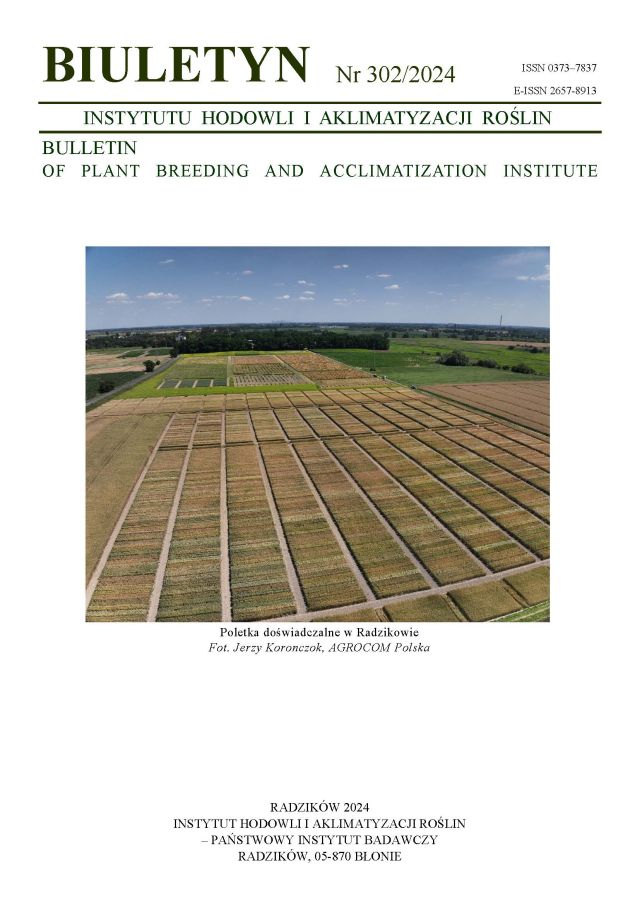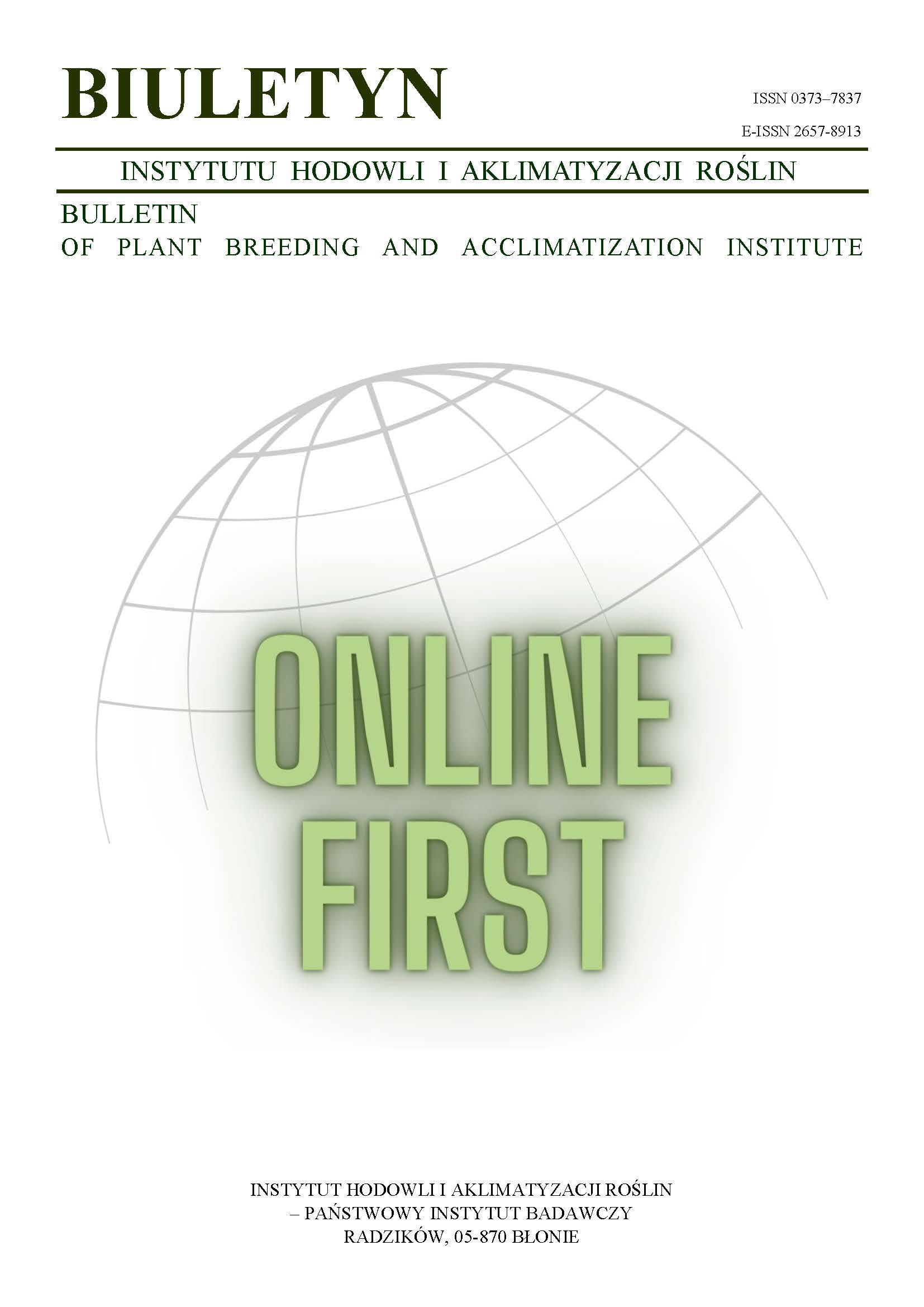Ralstonia solanacearum — the causative agent of brown rot of solanaceaus species
Anna Przetakiewicz
a.prztakiewicz@ihar.edu.plPracownia Hodowli Odpornościowej, Zakład Fitopatologii, Instytut Hodowli i Aklimatyzacji Roślin, Radzików (Poland)
Abstract
The paper presents biology and epidemiology of the pathogenic bacteria Ralstonia solanacearum causing brown rot in economically important plant species. Particular emphasis was put on species complexicity, broad range of plants susceptible to infection and on ways of bacterial dispersion. Symptoms of infection, risk associated with the latent infection and basic methods of detection of Ralstonia solanacearum in infected plant material are described in the paper.
Keywords:
Ralstonia solanacearum, brown rot of plants, diagnostic, disease symptoms, survival, susceptibilityReferences
Akiew E., Trevorrow P. R. 1994. Management of bacterial wilt of tobacco. In: Bacterial Wilt: The Disease and its Causative Agent, Pseudomonas solanacearum. A. C. Hayward and G. L. Hartman eds. CAB International, United Kingdom: 179 — 198.
Google Scholar
Anon. 1998. Council Directive 98/57/EC of 20 July 1998 on the control of Ralstonia solanacearum (Smith) Yabuuchi et al. Official J. Eur. Commun. L. 235: 1 — 39.
Google Scholar
Aspiras R. B., Cruz A. R. de la. 1985. Potential biological control of bacterial wilt in tomato and potato with Bacillus polymyxa FU6 and Pseudomonas fluorescens. In: Bacterial wilts diseases in Asia and the South Pacific. ACR Proceedings No. 13: 126 — 133.
Google Scholar
Autrique A., Potts M. J. 1987. The influence of mixed cropping on the control of bacterial blight wilt (Pseudomonas solanacearum). Ann. Appl. Biol. 111: 125 — 133.
DOI: https://doi.org/10.1111/j.1744-7348.1987.tb01439.x
Google Scholar
Boudazin G., Le Roux A. C., Josi K., Labare P., Jouan B. 1999. Design of division specific primers of Ralstonia solanacearum and application to the identification of European isolates. Eur. J. Plant Pathol. 105: 373 — 380.
DOI: https://doi.org/10.1023/A:1008763111230
Google Scholar
Borecki Z. 1996. Polskie nazwy chorób roślin uprawnych. Polskie Towarzystwo Fitopatologiczne, Poznań.
Google Scholar
Bradbury J. F. 1986. Guide to the plant pathogenic bacteria. CAB International, Wallingford, UK.
Google Scholar
Buddenhagen I. W., Kelman A. 1964. Biological and physiological aspects of bacterial wilt caused by Pseudomonas solanacearum. Ann. Rev. Phytopathol. 2: 203 — 230.
DOI: https://doi.org/10.1146/annurev.py.02.090164.001223
Google Scholar
Buddenhagen I. W., Sequeira L., Kelman A. 1962. Designation of races of Pseudomonas solanacearum. Phytopathology 52: 726.
Google Scholar
Buddenhagen I. W. 1986. Bacterial wilt revisited. In: Bacterial wilt disease in Asia and the South Pacific: proceedings of an international workshop held at PCARRD, Los Banos, Phillippines, 8–10 October 1985, edited by G. Persley. Canberra: ACIAR: 126 — 143.
Google Scholar
Caruso P., Morris M. T., Cambra M., Palomo J. L., Collar J., Lopez M. M. 2002. Enrichment Double-Antibody Sandwich Indirect Enzyme-linked Immunosorbent Assay that uses a specific monoclonal antibody for sensitive detection of Ralstonia solanacearum in asymptomatic potato tubers. Appl. Environ. Microbiol. 68: 3634 — 3638.
DOI: https://doi.org/10.1128/AEM.68.7.3634-3638.2002
Google Scholar
Cook D., Sequeira L. 1988. The use of restriction fragment length polymorphism (RFLP) analysis in taxonomy and diagnosis. Bacterial Wilt Newsletter, ACIAR No. 4: 4.
Google Scholar
DEFRA. 2001. Ring rot and brown rot of potato. Department for Environment, Food and Rural Affairs (DEFRA). http://www.defra.gov.uk/planth/pestnote/rot.htm.
Google Scholar
Echandi E. 1991. Bacterial wilt. In: Compendium of tobacco diseases (Ed. By Shew, H. D.; Lucas, G. B.). American Phytopathology Society, St. Paul, Minnesota, USA: 33 — 35.
Google Scholar
Elphinstone J. G. 1996. Survival and possible extinction of Pseudomonas solanacearum (Smith) Smith in cool climates. Potato Res. 39: 403 — 410.
DOI: https://doi.org/10.1007/BF02357946
Google Scholar
Elphinstone J. G., Stanford H., Stead D. E. 1998. Detection of Ralstonia solanacearum in potato tubers, Solanum dulcamara and associated irrigation water. In: Bacterial wilt disease: Molecular and ecological aspects. P. Prior, C. Allen, and J. Elphinstone, eds. Springer-Verlag, Heidelberg, Germany: 133 — 139.
DOI: https://doi.org/10.1007/978-3-662-03592-4_19
Google Scholar
Elphinstone J. G., Stead D. E. 2000. Standardization of methods for detection of Ralstonia solanacearum in potato. EPPO Bulletin 30: 391 — 396.
DOI: https://doi.org/10.1111/j.1365-2338.2000.tb00917.x
Google Scholar
Farag N. S., Fawzi F. G., El-Said S. I. A., Mikhail M. S. 1986. Streptomycin in relation to potato brown rot control. Acta Phytopathologica et Entomologica Hungarica 21: 115 — 122.
Google Scholar
Faraq N., Stead D. E., Janse J. D. 1999. Ralstonia (Pseudomonas) solanacearum race 3 biovar 2 detected in surface (irrigation) water in Egypt. J. Phytopathol. 147: 485 — 487.
DOI: https://doi.org/10.1046/j.1439-0434.1999.00038.x
Google Scholar
Fegan M., Prior P. 2005 How complex is the “Ralstonia solanacearum species complex”? In: Bacterial Wilt Disease and the Ralstonia solanacearum Species Complex. Allen C., Prior P., Hayward A. C. eds. American Phytopathology Society, St. Paul, Minnesota, USA: 449 — 461.
Google Scholar
Graham J., Jones D. A., Lloyd A. B. 1979. Survival of Pseudomonas solanacearum race 3 in plant debris and in latently infected potato tubers. Phytopathology 69: 1100 — 1103.
DOI: https://doi.org/10.1094/Phyto-69-1100
Google Scholar
Graham J., Lloyd A. B. 1979. Survival of potato strain (race 3) of Pseudomonas solanacearum in the deeper soil layers. Aust. J. Agri. Res. 30: 489 — 496.
DOI: https://doi.org/10.1071/AR9790489
Google Scholar
Granada G. A., Sequeira L. 1983. Survival of Pseudomonas solanacearum in soil, rhizosphere and plant roots. Can. J. Microbiol. 29: 433 — 440.
DOI: https://doi.org/10.1139/m83-070
Google Scholar
Grey B. E., Steck T. R. 2001. The viable but nonculturable state of Ralstonia solanacearum may be involved in long-term survival and plant infection. Appl. Environ. Microbiol. 67: 3866 — 3872.
DOI: https://doi.org/10.1128/AEM.67.9.3866-3872.2001
Google Scholar
Hay R. K. M. (ed). 2001. Scientific review 1997–2000. Scottish Agricultural Science Agency, Edinburgh, Scotland.
Google Scholar
Hayward A. C. 1991. Biology and epidemiology of bacterial wilt caused by Pseudomonas solanacearum. Ann. Rev. Phytopathol. 29: 65 — 87.
DOI: https://doi.org/10.1146/annurev.py.29.090191.000433
Google Scholar
Hayward A. C. 1964. Characteristics of Pseudomonas solanacearum. J. Appl. Bacteriol. 27: 265 — 277.
DOI: https://doi.org/10.1111/j.1365-2672.1964.tb04912.x
Google Scholar
Hayward A. C. 1994. The hosts of Pseudomonas solanacearum. In: Bacterial wilt: The disease and its Causative agent, Pseudomonas solanacearum. A. C. Hayward and G. L. Hartman, eds. CAB International, UK: 9 — 24.
Google Scholar
Hayward A. C. 1994 a. The hosts of Pseudomonas solanacearum. In: Bacterial wilt: the disease and its causative agent, Pseudomonas solanacearum (Ed. By Hayward, A. C.; Hartmann, G. LCAB International, Wallingford, UK): 9 — 24.
Google Scholar
Janse J. D. 1996. Potato brown rot in Western Europe: history, present occurrence and some remarks on possible origin, epidemiology and control strategies. Bulletin OEPP/EPPO Bulletin 26: 679 — 685.
DOI: https://doi.org/10.1111/j.1365-2338.1996.tb01512.x
Google Scholar
Janse J. D., Araluppen F. A. X., Schans J., Wenneker M., Westerhuis W. 1998. Experience with bacterial brown rot Ralstonia solanacearum biovar 2, rase 3 in the Netherlands. In: Bacterial Wilt Disease. Molecular and Ecological Aspects. P. Prior, C. Allen, and J. Elphinstone, eds. Springer-Verlag, Heidelberg, Germany: 46 — 152.
DOI: https://doi.org/10.1007/978-3-662-03592-4_21
Google Scholar
Janse J. D., van den Beld H. E., Elphinstone J., Simpkins S., Tjou-Tam-Sin L. N. A., van Vaerenbergh J. 2005. Introduction to Europe of Ralstonia solanacearum Biovar 2, Race 3 in Pelargonium zonale Cuttings from Kenya. In: Bacterial Wilt Disease and the Ralstonia solanacearum Species Complex. ed. Allen C., Prior P., Hayward A. C. American Phytopathology Society, St. Paul, Minnesota, USA: 81 — 94.
Google Scholar
Kelman A. 1953. The bacterial wilt caused by Pseudomonas solanacearum. N. C. Agr. Res. Sta. Tech. Bull.: 99.
Google Scholar
Kelman A. 1954. The relationship of patogenicity of Pseudomonas solanacearum to colony appearance on a tetrazolium medium. Phytopathology 44: 693 — 695.
Google Scholar
Kelman A., Hartman G. L., Hayward A. C. 1994. Introduction. In: Bacterial Wilt: The Disease and its Causative Agent, Pseudomonas solanacearum. A. C. Hayward and G. L. Hartman, eds. CAB International, UK: 1 — 8
Google Scholar
Machmund M., Middleton K. J. 1991. Transmission of Pseudomonas solanacearum through groundnut seed. ACIAR Bact. Wilt News. 7: 4 — 5.
Google Scholar
Moffett M. L., Wood B. A., Hayward A. C. 1981. Seed and soil: sources of inoculum for the colonization of the foliage of solanaceous hosts by Pseudomonas solanacearum. Ann. Appl. Biol. 98: 403 — 411.
DOI: https://doi.org/10.1111/j.1744-7348.1981.tb00772.x
Google Scholar
Murakoshi S., Takahashi M. 1984. Trials of some control of tomato wilt caused by Pseudomonas solanacearum. Bulletin of the Kanawaga Horticultural Experiment Station No. 31: 50 — 56.
Google Scholar
Nesmith W. C., Jenkins S. F., Jr. 1983. Survival of Pseudomonas solanacearum in selected North Carolina soils. Phytopathology 73: 1300 — 1304.
DOI: https://doi.org/10.1094/Phyto-73-1300
Google Scholar
Nesmith W. C., Jenkins S. F., Jr. 1985. Influence of antagonists and controlled matrix potential on the survival of Pseudomonas solanacearum in four North Carolina soils. Phytopathology 75: 1182 — 1187.
DOI: https://doi.org/10.1094/Phyto-75-1182
Google Scholar
OEPP/EPPO 1990 a. Quarantine procedures No. 26, Pseudomonas solanacearum. Bulletin OEPP/EPPO Bulletin 8: 2.
Google Scholar
OEPP/EPPO 1990b. Specific quarantine requirements. EPPO Technical Documents No. 1008.
Google Scholar
Olsson K. 1976. Experience of brown rot caused by Pseudomonas solanacearum (Smith) Smith in Sweden. Bulletin OEPP/EPPO Bulletin 6: 199 — 207.
DOI: https://doi.org/10.1111/j.1365-2338.1976.tb01546.x
Google Scholar
Opina N., Taner F., Holloway G., Wang J.-F., Li T. H., Maghirang R., Fegan M., Hayward A. C., Krishnapillai V., Hong W. F., Holloway B. W., Timmis J. N. 1997. A novel method for development of species and strain-specific DNA probes and PCR primers for identifying Burkholderia solanacearum (formerly Pseudomonas solanacearum. Asian-Pac. J. Mol. Biol. Biotechnol. 5: 19 — 33.
Google Scholar
Pastrik K. H., Maiss E. 2000. Detection of Ralstonia solanacearum in potato tubers by polymerase chain reaction. J. Phytopathol. 148: 619 — 626.
DOI: https://doi.org/10.1046/j.1439-0434.2000.00567.x
Google Scholar
Pastrik K. H., Elphinstone J. G., Pukall R. 2002. Differentiation and identification of Ralstonia solanacearum biovars by RAPD-PCR and analysis of amplified 16S-23S ribosomal intergenic spacer region. Eur. J. Plant Pathol. 108: 831 — 842.
DOI: https://doi.org/10.1023/A:1021218201771
Google Scholar
Persley G. J. (ed.). 1986. Bacterial wilt disease in Asia and the South Pacific. Proceedings of an International Workshop held at PCARRD, Los Banos, Philippines, 8-10 October 1985. ACIAR Press, Canberra.
Google Scholar
Robinson-Smith A., Jones P., Elphinstone J. G., Forde S. M. D. 1995. Production of antibodies to Pseudomonas solanacearum, the causative agent of bacterial wilt. Food Agric. Immunol. 7: 67 — 79.
DOI: https://doi.org/10.1080/09540109509354866
Google Scholar
Seal S. E., Jackson L. A., Young J. P. W., Daniels M. J. 1993. Differentiation of Pseudomonas solanacearum, Pseudomonas syzygii, Pseudomonas picketti and blood disease bacterium by partial 16S rRNA sequencing: construction of oligonucleotide primers for sensitive detection by polymerase chain reaction. J. Gen. Microbiol. 139: 1587 — 1594.
DOI: https://doi.org/10.1099/00221287-139-7-1587
Google Scholar
Shekhawat G. S., Perombelon M. C. M. 1991. Factors affecting survival in soil and virulence of Pseudomonas solanacearum. Z. Pflanzenk. U. Pflanzenschutz. 98: 258 — 267.
Google Scholar
Smith I. M., McNamara D. G., Scott P. R., Holderness M. 1997. Ralstonia solanacearum. In Quarantine Pests for Europe 2nd edition. EPPO/CABI.
Google Scholar
Timms-Wilson T. M., Bryant T., Bailey M. J. 2001. Strain characterization and 16S-23S probe development for differentiating geographically dispersed isolates of the phytopathogen Ralstonia solanacearum. Environ. Microbiol. 3: 785 — 797.
DOI: https://doi.org/10.1046/j.1462-2920.2001.00250.x
Google Scholar
Turco P., Saccardi A., Piazzi E., Martini G., Melegatti A., Xodo E., Gambin E. 1998. Monitoring of Ralstonia solanacearum in the Veneto region (Italy). Bulletin OEPP/EPPO Bulletin 28: 85 — 92.
DOI: https://doi.org/10.1111/j.1365-2338.1998.tb00708.x
Google Scholar
Van der Wolf J., Perombelon M. 1997. Potato brown rot in temperate regions — a review. http://www.spud.co.uk/external/PROF/RESEARCH/scri/brownro3.htm.
Google Scholar
Van Elsas J. D., Kastelein P., de Vries P. M., van Overbeek L. S. 2001. Effects of ecological factors on the survival and physiology of Ralstonia solanacearum bv 2 in irrigation water. Can. J. Microbiol. 47: 842 — 854.
DOI: https://doi.org/10.1139/w01-084
Google Scholar
Van Elsas J. D., Kastelein P., van Bekkum P., van der Wolf J. M., de Vries P. M., van Overbeek L. S. 2000. Survival of Ralstonia solanacearum biovar 2, the causative agent of potato brown rot, in field and microcosm soils in temperate climates. Phytopathology 90: 1338 — 1366.
DOI: https://doi.org/10.1094/PHYTO.2000.90.12.1358
Google Scholar
Xiao L. Z., Zhu Z. D., He K. L., Zhou M. N., Lin G. F. 1983. Observations of the infected portion of mulberry bacterial wilt by scanning electron microscopy. Sci. Sericult. 9: 58 — 59.
Google Scholar
Wullings B. A., Van Beuningen A. R., Janse J. D., Akkermans A. D. L. 1998. Detection of Ralstonia solanacearum, which causes brown rot of potato, by fluorescent in situ hybridization with 23S rRNA-targeted probes. Appl. Environ. Microbiol. 64: 4546 — 4554.
DOI: https://doi.org/10.1128/AEM.64.11.4546-4554.1998
Google Scholar
Yabuuchi E., Kosako Y., Yano I., Hotta H., Nishiuchi Y. 1995. Transfer of two Burkholderia and an Alcaligenes species to Ralstonia gen. nov.: Proposal of Ralstonia picketii (Ralston, Palleroni and Douderoff 1973) comb. nov., Ralstonia solanacearum (Smith 1896) comb. nov. and Ralstonia eutropha (Davis 1969) comb. nov. Microbiol. Immunol. 39: 897 — 904.
DOI: https://doi.org/10.1111/j.1348-0421.1995.tb03275.x
Google Scholar
Authors
Anna Przetakiewicza.prztakiewicz@ihar.edu.pl
Pracownia Hodowli Odpornościowej, Zakład Fitopatologii, Instytut Hodowli i Aklimatyzacji Roślin, Radzików Poland
Statistics
Abstract views: 34PDF downloads: 18
License
Copyright (c) 2006 Anna Przetakiewicz

This work is licensed under a Creative Commons Attribution-ShareAlike 4.0 International License.
Upon submitting the article, the Authors grant the Publisher a non-exclusive and free license to use the article for an indefinite period of time throughout the world in the following fields of use:
- Production and reproduction of copies of the article using a specific technique, including printing and digital technology.
- Placing on the market, lending or renting the original or copies of the article.
- Public performance, exhibition, display, reproduction, broadcasting and re-broadcasting, as well as making the article publicly available in such a way that everyone can access it at a place and time of their choice.
- Including the article in a collective work.
- Uploading an article in electronic form to electronic platforms or otherwise introducing an article in electronic form to the Internet or other network.
- Dissemination of the article in electronic form on the Internet or other network, in collective work as well as independently.
- Making the article available in an electronic version in such a way that everyone can access it at a place and time of their choice, in particular via the Internet.
Authors by sending a request for publication:
- They consent to the publication of the article in the journal,
- They agree to give the publication a DOI (Digital Object Identifier),
- They undertake to comply with the publishing house's code of ethics in accordance with the guidelines of the Committee on Publication Ethics (COPE), (http://ihar.edu.pl/biblioteka_i_wydawnictwa.php),
- They consent to the articles being made available in electronic form under the CC BY-SA 4.0 license, in open access,
- They agree to send article metadata to commercial and non-commercial journal indexing databases.














